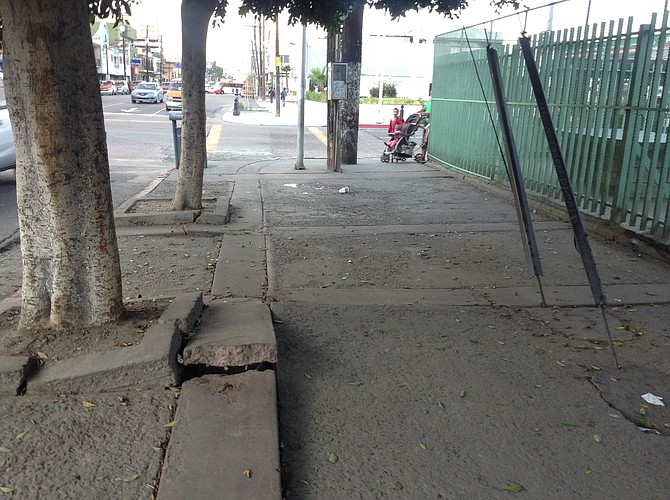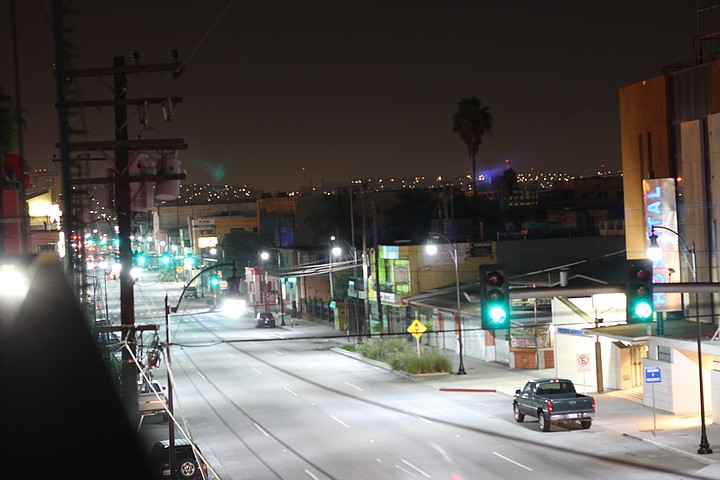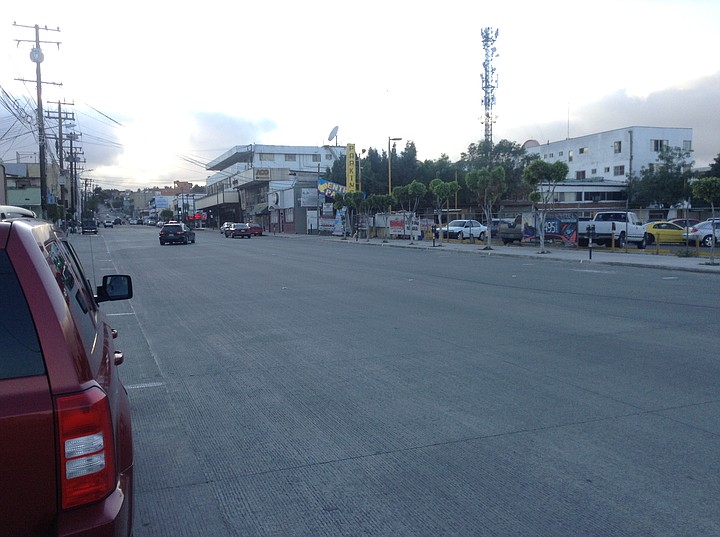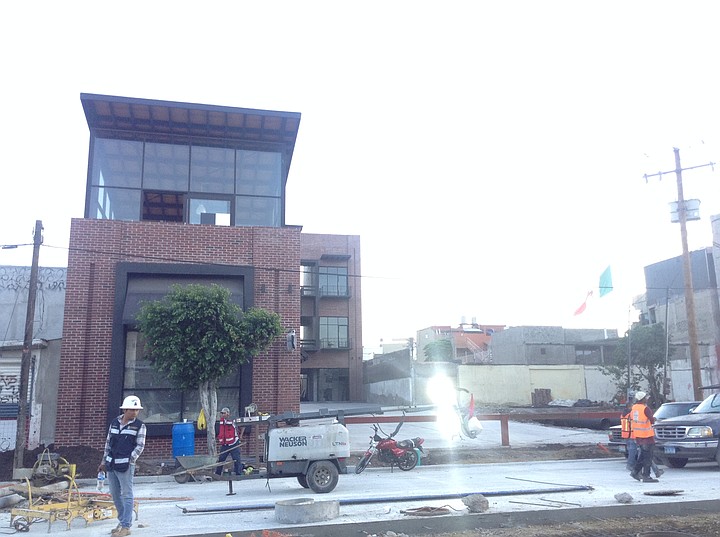 Facebook
Facebook
 X
X
 Instagram
Instagram
 TikTok
TikTok
 Youtube
Youtube

Last year, Calle Segunda in downtown Tijuana was destroyed in order to be redesigned. For a couple of months, it looked like the end of the world. Businesses and residents suffered difficult access and water shortages, sometimes living without running water for hours at a time.
Though completion was constantly pushed back, the new Calle Segunda is almost complete. By February 2015, before traffic and street lights functioned, traffic resumed on the street. Sidewalks also remained incomplete. Also in February, Tijuana mayor Jorge Astiazarán said that the new street would have semáforos inteligentes (“smart” traffic lights), would accommodate blind people, and the project would be completed in a month and a half.
In September, traffic lights were installed; they were activated in mid-October. Unfortunately, the traffic lights are not all that “smart.”

The lights work on a timer, one minute and ten seconds for the traffic flow of Calle Segunda, 50 seconds for the perpendicular cross-street. It does not matter if you press the pedestrian button or if heavy traffic is waiting, the sensors do not work. The traffic-light posts have braille writing above the pedestrian button, but it does not generate a sound, defeating the purpose of helping blind people.

Despite all of that, Calle Segunda looks better than ever. Many of the electric and telephone cables that had been hanging from posts have been taken down and installed underground. Street lights are turned on around dawn and are nearly as bright as those along the border wall. Planters with roses, cacti, and ground cover were placed on the widened sidewalk. Calle Segunda is now bright at night and feels safer, but most of downtown, outside of Segunda and Revolución, still feels dark and eerie.
“La caja pluvial no tiene bomba [the storm drain doesn't have a pump],” Poncho, a store clerk on Segunda, tells me. “The water just stays under the street, mixes with the drainage, and it has nowhere to go.” Poncho explains that during the rainy season, the street can turn into a river of shit. He says the store has suffered a significant decline in sales during the reconstruction.
Calle Segunda is not the only street in downtown to get a major overhaul. The cross-streets of 3rd and Madero also received a facelift. The brand-new-looking street and sidewalk extends one block in either direction, to a new Pemex gas station that sits on the corner of 4th and Madero. Across the street, near a public school, the sidewalk is crooked, a section thrust upward from old roots.


Calle Novena (9th) also got treated to a new concrete street and better drainage system. Calle Diez (10th) is currently being worked on, with completion estimates for the end of this month. Zona Norte also got a couple of medians, and sidewalks are being improved.
“Signs of gentrification start to appear in the city from 20 de Noviembre neighborhood to downtown,” urban planning specialist Tito Alegría recently told Jornada news. It doesn't take an expert to notice gentrification trends in the city.
Many modern apartment complexes have appeared in the trendy uptown neighborhood known as La Cacho. Food courts (with gastro trucks), modern cafés, breweries, and bars, have been popping up all over the city.
Bustamante Realty Group erected two modern buildings of exposed brick in downtown. One of the buildings is on the new Calle Diez. The building has a sign for offices for rent. The space facing the street already has the sign for popular coffee shop, Das Cortes, to be opened soon. The other building, located on 7th and Constitución, was unveiled last year, with a high-end sushi restaurant on the bottom floor and “urban lofts” up top (the restaurant did not last).
The realty group website states “we are looking for renters with certain type of profile that generate a sensible community.”


Last year, Calle Segunda in downtown Tijuana was destroyed in order to be redesigned. For a couple of months, it looked like the end of the world. Businesses and residents suffered difficult access and water shortages, sometimes living without running water for hours at a time.
Though completion was constantly pushed back, the new Calle Segunda is almost complete. By February 2015, before traffic and street lights functioned, traffic resumed on the street. Sidewalks also remained incomplete. Also in February, Tijuana mayor Jorge Astiazarán said that the new street would have semáforos inteligentes (“smart” traffic lights), would accommodate blind people, and the project would be completed in a month and a half.
In September, traffic lights were installed; they were activated in mid-October. Unfortunately, the traffic lights are not all that “smart.”

The lights work on a timer, one minute and ten seconds for the traffic flow of Calle Segunda, 50 seconds for the perpendicular cross-street. It does not matter if you press the pedestrian button or if heavy traffic is waiting, the sensors do not work. The traffic-light posts have braille writing above the pedestrian button, but it does not generate a sound, defeating the purpose of helping blind people.

Despite all of that, Calle Segunda looks better than ever. Many of the electric and telephone cables that had been hanging from posts have been taken down and installed underground. Street lights are turned on around dawn and are nearly as bright as those along the border wall. Planters with roses, cacti, and ground cover were placed on the widened sidewalk. Calle Segunda is now bright at night and feels safer, but most of downtown, outside of Segunda and Revolución, still feels dark and eerie.
“La caja pluvial no tiene bomba [the storm drain doesn't have a pump],” Poncho, a store clerk on Segunda, tells me. “The water just stays under the street, mixes with the drainage, and it has nowhere to go.” Poncho explains that during the rainy season, the street can turn into a river of shit. He says the store has suffered a significant decline in sales during the reconstruction.
Calle Segunda is not the only street in downtown to get a major overhaul. The cross-streets of 3rd and Madero also received a facelift. The brand-new-looking street and sidewalk extends one block in either direction, to a new Pemex gas station that sits on the corner of 4th and Madero. Across the street, near a public school, the sidewalk is crooked, a section thrust upward from old roots.


Calle Novena (9th) also got treated to a new concrete street and better drainage system. Calle Diez (10th) is currently being worked on, with completion estimates for the end of this month. Zona Norte also got a couple of medians, and sidewalks are being improved.
“Signs of gentrification start to appear in the city from 20 de Noviembre neighborhood to downtown,” urban planning specialist Tito Alegría recently told Jornada news. It doesn't take an expert to notice gentrification trends in the city.
Many modern apartment complexes have appeared in the trendy uptown neighborhood known as La Cacho. Food courts (with gastro trucks), modern cafés, breweries, and bars, have been popping up all over the city.
Bustamante Realty Group erected two modern buildings of exposed brick in downtown. One of the buildings is on the new Calle Diez. The building has a sign for offices for rent. The space facing the street already has the sign for popular coffee shop, Das Cortes, to be opened soon. The other building, located on 7th and Constitución, was unveiled last year, with a high-end sushi restaurant on the bottom floor and “urban lofts” up top (the restaurant did not last).
The realty group website states “we are looking for renters with certain type of profile that generate a sensible community.”
Comments